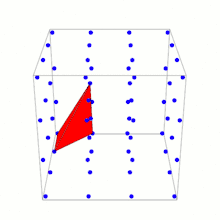Reeve tetrahedron

In geometry, the Reeve tetrahedron is a polyhedron, in three-dimensional space with vertices at (0, 0, 0), (1, 0, 0), (0, 1, 0) and (1, 1, r) where r is a positive integer. It is named after John Reeve, who used it to show that higher-dimensional generalizations of Pick's theorem do not exist.
Counterexample to generalizations of Pick's theorem
Each vertex of the Reeve tetrahedron lies on a fundamental lattice point (a point in ℤ3). No other fundamental lattice points lie on the surface or in the interior of the tetrahedron. The volume of the Reeve tetrahedron is r/6. In 1957 Reeve used this tetrahedron to show that there exist tetrahedra with four lattice points as vertices, and containing no other lattice points, but with arbitrarily large volume.[1]
In two dimensions, the area of every polyhedron with lattice vertices is determined as a formula of the number of lattice points at its vertices, on its boundary, and in its interior, according to Pick's theorem. The Reeve tetrahedra imply that there can be no corresponding formula for the volume in three or more dimensions. Any such formula would be unable to distinguish the Reeve tetrahedra with different choices of r from each other, but their volumes are different from each other.[1]
Despite this negative result, it is possible (as Reeve showed) to devise a more complicated formula for lattice polyhedron volume that combines the number of lattice points in the polyhedron, the number of points of a finer lattice in the polyhedron, and the Euler characteristic of the polyhedron.[1][2]
Ehrhart polynomial
The Ehrhart polynomial of any lattice polyhedron counts the number of lattice points that it contains when scaled up by an integer factor. The Ehrhart polynomial of the Reeve tetrahedron Tr of height r is[3]
Thus, for r ≥ 13, the coefficient of t in the Ehrhart polynomial of Tr is negative. This example shows that Ehrhart polynomials can sometimes have negative coefficients.[3]
References
- 1 2 3 Reeve, J. E. (1957). "On the volume of lattice polyhedra". Proceedings of the London Mathematical Society. Third Series. 7: 378–395. doi:10.1112/plms/s3-7.1.378. MR 0095452.
- ↑ Kołodziejczyk, Krzysztof (1996). "An "odd" formula for the volume of three-dimensional lattice polyhedra". Geometriae Dedicata. 61 (3): 271–278. doi:10.1007/BF00150027. MR 1397808.
- 1 2 Beck, Matthias; Robins, Sinai (2015). Computing the Continuous Discretely: Integer-Point Enumeration in Polyhedra. Undergraduate Texts in Mathematics (Second ed.). New York: Springer. pp. 78–79, 82. doi:10.1007/978-1-4939-2969-6. ISBN 978-1-4939-2968-9. MR 3410115.